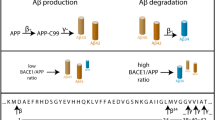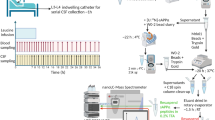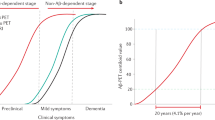Abstract
Aim:
To identify a small molecule L655,240 as a novel β-secretase (BACE1) inhibitor and to investigate its effects on β-amyloid (Aβ) generation in vitro.
Methods:
Fluorescence resonance energy transfer (FRET) was used to characterize the inhibitory effect of L655,240 on BACE1. Surface plasmon resonance (SPR) technology-based assay was performed to study the binding affinity of L655,240 for BACE1. The selectivity of L655,240 toward BACE1 over other aspartic proteases was determined with enzymatic assay. The effects of L655,240 on Aβ40, Aβ42, and sAPPβ production were studied in HEK293 cells stably expressing APP695 Swedish mutantK595N/M596L (HEK293-APPswe cells). The activities of BACE1, γ-secretase and α-secretase were assayed, and both the mRNA and protein levels of APP and BACE1 were evaluated using real-time PCR (RT-PCR) and Western blot analysis.
Results:
L655,240 was determined to be a competitive, selective BACE1 inhibitor (IC50=4.47±1.37 μmol/L), which bound to BACE1 directly (KD=17.9±0.72 μmol/L). L655,240 effectively reduced Aβ40, Aβ42, and sAPPβ production by inhibiting BACE1 without affecting the activities of γ-secretase and α-secretase in HEK293-APPswe cells. L655,240 has no effect on APP and BACE1 mRNA or protein levels in HEK293-APPswe cells.
Conclusion:
The small molecule L655,240 is a novel BACE1 inhibitor that can effectively decreases Aβ production in vitro, thereby highlighting its therapeutic potential for the treatment of Alzheimer's disease.
Similar content being viewed by others
Log in or create a free account to read this content
Gain free access to this article, as well as selected content from this journal and more on nature.com
or
References
Querfurth HW, LaFerla FM . Alzheimer's disease. N Engl J Med 2010; 362: 329–44.
Wollen KA . Alzheimer' disease: the pros and cons of phamaceutical, nutritional, botanical, and stimulatory therapies, with a discussion of treatment strategies from the perspective of patients and practitioners. Altern Med Rev 2010; 15: 223–44.
Hansen RA, Gartlehner G, Webb AP, Morgan LC, Moore CG, Jonas DE . Efficacy and safety of donepezil, galantamine, and rivastigmine for the treatment of Alzheimer's disease: a systematic review and meta-analysis. Clin Interv Aging 2008; 3: 211–25.
McShane R, Areosa Sastre A, Minakaran N . Memantine for dementia. Cochrane Database Syst Rev 2006; CD003154.
Ohrui T, Tomita N, Sato-Nakagawa T, Matsui T, Maruyama M, Niwa K, et al. Effects of brain-penetrating ACE inhibitors on Alzheimer disease progression. Neurology 2004; 63: 1324–5.
Maxwell CJ, Hogan DB, Ebly EM . Calcium-channel blockers and cognitive function in elderly people: results from the Canadian Study of Health and Aging. CMAJ 1999; 161: 501–6.
Vlad SC, Miller DR, Kowall NW, Felson DT . Protective effects of NSAIDs on the development of Alzheimer disease. Neurology 2008; 70: 1672–7.
Li X, Bo H, Zhang XC, Hartsuck JA, Tang J . Predicting memapsin 2 (beta-secretase) hydrolytic activity. Protein Sci 2010; 19: 2175–85.
Cole SL, Vassar R . The basic biology of BACE1: a key therapeutic target for Alzheimer's disease. Curr Genomics 2007; 8: 509–30.
Citron M . Beta-secretase as a target for the treatment of Alzheimer's disease. J Neurosci Res 2002; 70: 373–9.
Ohno M, Sametsky EA, Younkin LH, Oakley H, Younkin SG, Citron M, et al. BACE1 deficiency rescues memory deficits and cholinergic dysfunction in a mouse model of Alzheimer's disease. Neuron 2004; 41: 27–33.
Ohno M, Chang L, Tseng W, Oakley H, Citron M, Klein WL, et al. Temporal memory deficits in Alzheimer's mouse models: rescue by genetic deletion of BACE1. Eur J Neurosci 2006; 23: 251–60.
Ohno M, Cole SL, Yasvoina M, Zhao J, Citron M, Berry R, et al. BACE1 gene deletion prevents neuron loss and memory deficits in 5XFAD APP/PS1 transgenic mice. Neurobiol Dis 2007; 26: 134–45.
Cai H, Wang Y, McCarthy D, Wen H, Borchelt DR, Price DL, et al. BACE1 is the major beta-secretase for generation of Abeta peptides by neurons. Nat Neurosci 2001; 4: 233–4.
Luo Y, Bolon B, Kahn S, Bennett BD, Babu-Khan S, Denis P, et al. Mice deficient in BACE1, the Alzheimer's beta-secretase, have normal phenotype and abolished beta-amyloid generation. Nat Neurosci 2001; 4: 231–2.
Roberds SL, Anderson J, Basi G, Bienkowski MJ, Branstetter DG, Chen KS, et al. BACE knockout mice are healthy despite lacking the primary beta-secretase activity in brain: implications for Alzheimer's disease therapeutics. Hum Mol Genet 2001; 10: 1317–24.
Wong PC, Zheng H, Chen H, Becher MW, Sirinathsinghji DJ, Trumbauer ME, et al. Presenilin 1 is required for Notch1 and DII1 expression in the paraxial mesoderm. Nature 1997; 387: 288–92.
Shen J, Bronson RT, Chen DF, Xia W, Selkoe DJ, Tonegawa S . Skeletal and CNS defects in Presenilin-1-deficient mice. Cell 1997; 89: 629–39.
Donoviel DB, Hadjantonakis AK, Ikeda M, Zheng H, Hyslop PS, Bernstein A . Mice lacking both presenilin genes exhibit early embryonic patterning defects. Genes Dev 1999; 13: 2801–10.
Hong L, Koelsch G, Lin X, Wu S, Terzyan S, Ghosh AK, et al. Structure of the protease domain of memapsin 2 (beta-secretase) complexed with inhibitor. Science 2000; 290: 150–3.
Kimura T, Shuto D, Hamada Y, Igawa N, Kasai S, Liu P, et al. Design and synthesis of highly active Alzheimer's beta-secretase (BACE1) inhibitors, KMI-420 and KMI-429, with enhanced chemical stability. Bioorg Med Chem Lett 2005; 15: 211–5.
Asai M, Hattori C, Iwata N, Saido TC, Sasagawa N, Szabo B, et al. The novel beta-secretase inhibitor KMI-429 reduces amyloid beta peptide production in amyloid precursor protein transgenic and wild-type mice. J Neurochem 2006; 96: 533–40.
Hussain I, Hawkins J, Harrison D, Hille C, Wayne G, Cutler L, et al. Oral administration of a potent and selective non-peptidic BACE-1 inhibitor decreases beta-cleavage of amyloid precursor protein and amyloid-beta production in vivo. J Neurochem 2007; 100: 802–9.
Iserloh U, Pan J, Stamford AW, Kennedy ME, Zhang Q, Zhang L, et al. Discovery of an orally efficaceous 4-phenoxypyrrolidine-based BACE-1 inhibitor. Bioorg Med Chem Lett 2008; 18: 418–22.
Luo X, Yan R . Inhibition of BACE1 for therapeutic use in Alzheimer's disease. Int J Clin Exp Pathol 2010; 3: 618–28.
Cole DC, Manas ES, Stock JR, Condon JS, Jennings LD, Aulabaugh A, et al. Acylguanidines as small-molecule beta-secretase inhibitors. J Med Chem 2006; 49: 6158–61.
Baxter EW, Conway KA, Kennis L, Bischoff F, Mercken MH, Winter HL, et al. 2-Amino-3,4-dihydroquinazolines as inhibitors of BACE-1 (beta-site APP cleaving enzyme): Use of structure based design to convert a micromolar hit into a nanomolar lead. J Med Chem 2007; 50: 4261–4.
Fukumoto H, Takahashi H, Tarui N, Matsui J, Tomita T, Hirode M, et al. A noncompetitive BACE1 inhibitor TAK-070 ameliorates Abeta pathology and behavioral deficits in a mouse model of Alzheimer's disease. J Neurosci 2010; 30: 11157–66.
Jeon SY, Bae K, Seong YH, Song KS . Green tea catechins as a BACE1 (beta-secretase) inhibitor. Bioorg Med Chem Lett 2003; 13: 3905–8.
Hwang EM, Ryu YB, Kim HY, Kim DG, Hong SG, Lee JH, et al. BACE1 inhibitory effects of lavandulyl flavanones from Sophora flavescens. Bioorg Med Chem 2008; 16: 6669–74.
Choi YH, Yoo MY, Choi CW, Cha MR, Yon GH, Kwon DY, et al. A new specific BACE-1 inhibitor from the stembark extract of Vitis vinifera. Planta Med 2009; 75: 537–40.
Zhu Z, Li C, Wang X, Yang Z, Chen J, Hu L, et al. 2,2′,4′-trihydroxychalcone from Glycyrrhiza glabra as a new specific BACE1 inhibitor efficiently ameliorates memory impairment in mice. J Neurochem 2009; 114: 374–85.
Hall RA, Gillard J, Guindon Y, Letts G, Champion E, Ethier D, et al. Pharmacology of L-655,240 (3-[1-(4-chlorobenzyl)-5-fluoro-3-methyl-indol-2-yl]2,2-dimethylpro pan oic acid); a potent, selective thromboxane/prostaglandin endoperoxide antagonist. Eur J Pharmacol 1987; 135: 193–201.
Conroy DM, Sirois P . Early bronchial hyperresponsiveness following injection of sephadex beads in the guinea pig: involvement of platelet activating factor and thromboxane A2 . Inflammation 1999; 23: 437–48.
Wainwright CL, Parratt JR . The effects of L655,240, a selective thromboxane and prostaglandin endoperoxide antagonist, on ischemia- and reperfusion-induced cardiac arrhythmias. J Cardiovasc Pharmacol 1988; 12: 264–71.
Xu Y, Li MJ, Greenblatt H, Chen W, Paz A, Dym O, et al. Flexibility of the flap in the active site of BACE1 as revealed by crystal structures and molecular dynamics simulations. Acta Crystallogr D Biol Crystallogr 2011; 68: 13–25.
Liu Q, Zhang Y, Lin Z, Shen H, Chen L, Hu L, et al. Danshen extract 15,16-dihydrotanshinone I functions as a potential modulator against metabolic syndrome through multi-target pathways. J Steroid Biochem Mol Biol 2010; 120: 155–63.
Cachard-Chastel M, Lezoualc'h F, Dewachter I, Delomenie C, Croes S, Devijver H, et al. 5-HT4 receptor agonists increase sAPPalpha levels in the cortex and hippocampus of male C57BL/6j mice. Br J Pharmacol 2007; 150: 883–92.
Wang L, Wang X, Chen J, Yang Z, Yu L, Hu L, et al. Activation of protein serine/threonine phosphatase PP2Calpha efficiently prevents liver fibrosis. PLoS One 2010; 5: e14230.
Kopan R, Goate A . A common enzyme connects notch signaling and Alzheimer's disease. Genes Dev 2000; 14: 2799–806.
Louvi A, Artavanis-Tsakonas S . Notch signalling in vertebrate neural development. Nat Rev Neurosci 2006; 7: 93–102.
Allinson TM, Parkin ET, Turner AJ, Hooper NM . ADAMs family members as amyloid precursor protein alpha-secretases. J Neurosci Res 2003; 74: 342–52.
Weidemann A, Konig G, Bunke D, Fischer P, Salbaum JM, Masters CL, et al. Identification, biogenesis, and localization of precursors of Alzheimer's disease A4 amyloid protein. Cell 1989; 57: 115–26.
Tomita S, Kirino Y, Suzuki T . Cleavage of Alzheimer's amyloid precursor protein (APP) by secretases occurs after O-glycosylation of APP in the protein secretory pathway. Identification of intracellular compartments in which APP cleavage occurs without using toxic agents that interfere with protein metabolism. J Biol Chem 1998; 273: 6277–84.
Glenner GG, Wong CW . Alzheimer's disease: initial report of the purification and characterization of a novel cerebrovascular amyloid protein. Biochem Biophys Res Commun 1984; 120: 885–90.
Tanzi RE, Bertram L . Twenty years of the Alzheimer's disease amyloid hypothesis: a genetic perspective. Cell 2005; 120: 545–55.
Karran E, Mercken M, De Strooper B . The amyloid cascade hypothesis for Alzheimer's disease: an appraisal for the development of therapeutics. Nat Rev Drug Discov 2011; 10: 698–712.
Hardy J, Allsop D . Amyloid deposition as the central event in the aetiology of Alzheimer's disease. Trends Pharmacol Sci 1991; 12: 383–8.
Hussain I, Powell D, Howlett DR, Tew DG, Meek TD, Chapman C, et al. Identification of a novel aspartic protease (Asp 2) as beta-secretase. Mol Cell Neurosci 1999; 14: 419–27.
Citron M, Westaway D, Xia W, Carlson G, Diehl T, Levesque G, et al. Mutant presenilins of Alzheimer's disease increase production of 42-residue amyloid beta-protein in both transfected cells and transgenic mice. Nat Med 1997; 3: 67–72.
Acknowledgements
This work was supported by the State Key Program of Basic Research of China (No 2010CB912501), the National Natural Science Foundation of China (No 81173105 and 30890044), the Science Foundation of Shanghai (No 11XD1406100 and 11ZR1444500) and the Foundation of the Chinese Academy of Sciences (No KSCX2-EW-Q-3).
Author information
Authors and Affiliations
Corresponding authors
Rights and permissions
About this article
Cite this article
Lu, Q., Chen, Wy., Zhu, Zy. et al. L655,240, acting as a competitive BACE1 inhibitor, efficiently decreases β-amyloid peptide production in HEK293-APPswe cells. Acta Pharmacol Sin 33, 1459–1468 (2012). https://doi.org/10.1038/aps.2012.74
Received:
Accepted:
Published:
Issue date:
DOI: https://doi.org/10.1038/aps.2012.74



